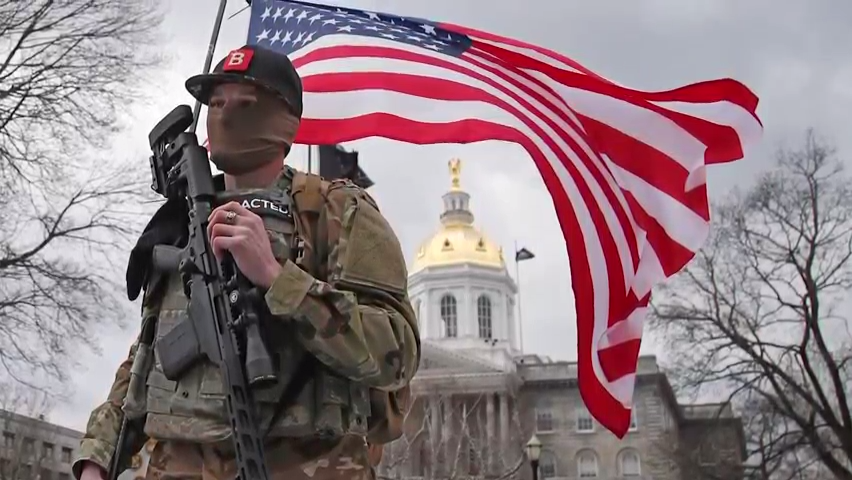White supremacist propaganda hit an all-time high in 2020, new report says
Incidents of white supremacist propaganda hit an all-time high in 2020, according to a new report from the Anti-Defamation League's Center on Extremism, which has tracked racist propaganda for decades. anti-Semitic, racist and anti-LGBTQ+ posters, flyers and graffiti were recorded 5,125 times in 2020, according to the report, almost twice the number of incidents recorded in 2019.
The report, released today, details incidents in every state excluding Hawaii. It includes 130 incidents of white supremacists putting up banners, 56 in-person white supremacist events and 283 incidents of anti-Semitc language or propaganda that specifically targeted Jewish institutions, a 68% increase from 2019.
Oren Segal, vice president of the Center on Extremism, said the increased propaganda is another indication of how divided America has become.
"As if a pandemic, social justice protests and a polarizing election were not enough, one of the other things we've been dealing with is a significant increase in efforts by white supremacists to spread their messages around the country," Segal said. "What the numbers suggest is a doubling down on what they view as a successful tactic."
At least 30 different white supremacist groups distributed flyers, put up posters or graffitied public and private spaces last year, the report says. The messaging varied from overt neo-Nazi propaganda to coded language that disguised white supremacist messaging inside expressions of patriotism and nationalism.
Three organizations were responsible for more than 90% of the propaganda incidents. The most active group by far was Texas-based Patriot Front, headed by white supremacist Thomas Rousseau, which was behind 4,105 of the incidents. Patriot Front masks its racism in vague phrases like "America First" and "Reclaim America," but the group's official manifesto makes its white supremacist goals clear.
The @PatriotFrontOfficial Channel on the secure messaging app Telegram also regularly posts openly racist and anti-Semitic messages, as well as documenting the group's acts of white supremacist vandalism.
Sarah Vinson, a forensic psychiatrist and associate professor of psychiatry and behavioral sciences at Morehouse School of Medicine, said white supremacist propaganda has a dual impact on the communities where it appears:
"When you see these signs up, it can make you less trusting of the white people you're around, because you don't know who it is that put it up, and you don't know who is tolerating that," Vinson said. "White people who harbor those beliefs may also find those signs validating and reassuring."
Offline expression of online activity
In recent years, white supremacists have increasingly gathered online using social media, message boards and chatrooms. It may seem surprising, therefore, to see such a spike in old-school techniques like putting up posters and distributing flyers.
But Segal said the increase in propaganda isn't an alternative to online activity, but a reflection of how technology is helping white supremacist views propagate.
"The ability for white supremacist groups to crowdsource their propaganda online results in the increase that we're seeing on the ground," Segal said. "Anybody can access these materials online and then go out into their community and post it there. So while it's an old tactic, it's being helped by modern technology."
Propaganda mirrors increases in hate groups, hate crime
The increase in white supremacist propaganda mirrors an overall national increase in both the number of hate groups in the United States and hate crimes over the last few years.
The Southern Poverty Law Center's annual audit of hate groups showed a slight dip in the number of groups counted in 2020 from 2019. But experts were quick to point out that the number of hate groups remains high by historical standards.
The most recent statistics on hate crimes from the FBI, a tally that is deeply flawed but offers some historical perspective, suggested fatal hate crimes rising to record levels in 2019, the most recent year for which data is available.
More: FBI report shows US hate crimes reached the highest level since 2008
More recently, there has been a surge in hate crimes toward Asian Americans, stemming from racist tropes about the COVID-19 pandemic.
Hate crimes against Asian Americans rose almost 150% in 2020 in a study of America's 16 largest cities by the Center for the Study of Hate & Extremism at California State University, San Bernardino.

Social media platforms get failing grade on hate
Another report released this week by the Simon Wiesenthal Center, a global Jewish human rights organization, assessed social media platforms' policies for targeting hate online.
It concluded that not one of the major platforms should receive an A grade.
The report criticizes social media companies for being too slow, and too selective, in tackling white supremacist, anti-Semitic, anti-LGBTQ+ and anti-immigrant content.
“It is worrisome to see us moving in the wrong direction at this juncture in history,” said Rabbi Abraham Cooper, who has led the center's digital terrorism and hate project for nearly three decades. “Social media giants, who for decades moved slowly and incrementally against online hate, suddenly entered the political arena, impacting on elections and Covid-related health issues."
The report gave the "Big 5" tech platforms – Facebook/Instagram, Twitter and YouTube/Google – all B-minus grades. Telegram, which has seen a surge of new users who were kicked off Facebook and Twitter, got a D-minus grade. White supremacists' favorite social media site, Gab, got an F.
This article originally appeared on USA TODAY: white supremacist propaganda hits an all-time high

